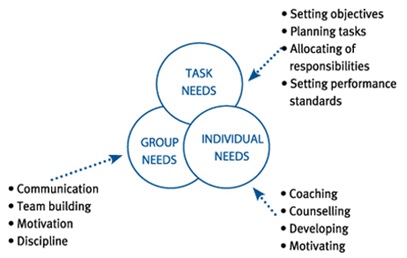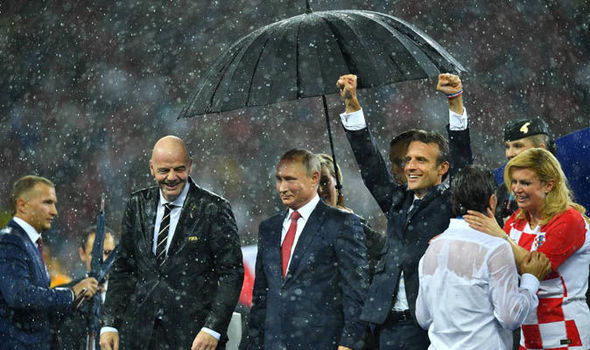What is Leadership? Models and Theories
A leader is someone charismatic, assertive or a role model we are willing to follow. Our society has been full of leaders and followers since the creation of humanity, imagine the first cave man guiding the group to survival, or Moses guiding the Hebrews to the promised land through the opened Red Sea with the Egyptian army behind, or Joan of Arc miraculously recruiting French soldiers to follow her into battle (Bennis 2007). Leadership is commonly described as “getting others to follow or getting people to do things willingly” (Mullins 2016: 313).
Leadership is the relationship in which people are influenced by the behavior or actions of one individual (Mullins 2016: 314). McCleskey (2014) argued that the study of leadership spans more than a century ago and one of the earliest studies about it is Galton’s (1869) Hereditary Genius which came up with the Great Man Theory, basically stating that leadership is a characteristic ability of extraordinary individuals (McCleskey 2014).
An authority on leadership and management is John Adair, a British writer, best-known for his three-circle model of Action-Centred Leadership (John Adair 2018). Forty-five years ago, in 1973 he stated that leader’s effectiveness depends on meeting three areas of need: the need to achieve common tasks, the need of team maintenance and the individual needs of group members (Mullins 2016: 316).

Source: (Tomoko Leadership 2018)
Rost (1993) discovered 221 different definitions and conceptions of leadership; therefore, the correct definition will depend on the specific aspect of leadership of interest to the individual (Bass, 2008). Let’s analyze the Adair’s three-circle model of Action-Centred Leadership through three conceptions of leadership that evolved from theories from more than 50 years ago, these are Situational, Transactional and Transformational (McCleskey 2014).
Situational leadership evolved from a task-oriented leadership where the leader defines the roles for the followers (Bass 2008), he is required to have a rational understanding of the situation rather than been charismatic with a large group of dedicated followers (Graeff 1997). The transformational leader convinces his followers to transcend their self-interest for the sake of the organization, while elevating “the followers’ level of need for achievement and self-actualization” (Bass, 2008). Burns (1978) described Transactional leadership theory as the relationship between leaders and followers as a series of gratification exchanges designed to maximize organizational and individual gains. Despite these definitions and other leadership styles, researches revealed that no particular style was universally effective and these leadership theories relied on abstract leadership types that were difficult to identify (Glynn & DeJordy, 2010). In the next picture from the World Cup Final in Moscow we can observe the 3 styles of leadership at once.

Source: (Express UK 2018)
A Change of Era, Future of Leadership
According to Hitt (1998), “we are on the precipice of an era”, in the midpoint of a new knowledge-oriented economy, in which a complex competitive landscape, driven mostly by technology and globalization, is faced by present organizations (McCleskey 2014). The world changes every minute, globalization and technological revolution are bringing us together each day, we are becoming, little by little, one big country with different languages and cultures. We are adopting foreign manners; more and more western leadership theories and models are being studied and practiced by organizations and countries. Nevertheless, nowadays most of the leadership theories are outdated, at least half-century old. These theories come from the industrial era in the western world, according to Manville & Ober (2003) we are living in an economy based on knowledge, but our managerial challenge is to get rid of the past systems and come up with totally new ones. Unfortunately, we are still firmly planted in structures, governance systems and incentive programs of the industrial age. (Manville & Ober 2003)
Enterprises in developing countries prefer manufacturing activities, while firms in developed economies are focusing more on information and services (Drucker 1999). In the industrial age, the challenge was to coordinate and optimize production and movement of products by employees in (Boisot 1998), 1938 Chester Barnard stated that leadership was aligning individual preferences with organizational goals. In this knowledge era, the organization’s success lies more in its social assets than in its physical assets (McKelvey, 2001). Airbnb, Facebook, Uber, Alibaba and Google are just an example of organizations having less physical assets and focusing more on the people working for them (Libert, Wind and Beck 2014).
Here lies the question about Leadership, how to come with a new model that includes all the models and aligns towards the new era? Are today’s ways of leadership meeting everyone’s expectations within an organization? Are we more focused on inspiring people to align with and commit to organizational goals, or in efficient and effective production? (House & Mitchell 1974; Zaccaro & Klimoski 2001). Sadly, we still motivate people through carrot-and-stick incentives (Manville & Ober 2003).

Source: (Penwill 2018)
Leadership will mutate, transform and adapt to the future world demands. Leadership had been developing since the beginning of our times, since the Ancient Geeks, the Roman Empire, the Middle Ages, the Industrial Revolution and the Knowledge Age; except that in recent years we decided to conceptualize it and make it into theories. The world is moving onto a more equal one in which leadership theories will focus more on people’s need and quality life than their results.
References
Bass, B. M. (2008). The Bass handbook of leadership: Theory, research, & managerial applications. (4th ed.). New York, NY: Free Press.
Bennis, W. (2007) ‘The Challenges of Leadership in the Modern World’. American Psychologist [online] 62 (1), 2–5, <https://pdfs.semanticscholar.org/674f/3586e2a4d1281faaa885df34eb9d621f8911.pdf> [14 July 2018]
Barnard, C.I. (1938) The functions of the executive. Cambridge, MA: Harvard University Press.
Boisot, M. H. (1998) Knowledge assets: Securing competitive advantage in the information economy. Oxford: Oxford University Press.
Burns, J. M. (1978). Leadership. New York, NY: HarperCollins.
Drucker, P. F. (1998) ‘Management’s new paradigms’ Forbes [online] 162 (7), 152–170, available from <https://www.forbes.com/forbes/1998/1005/6207152a.html#40dbf7a931ee> [14 July 2018]
Express UK (2018) World Cup final: Macron SOAKED at winners’ presentation as umbrella ONLY held over Putin [online] available from
<https://www.express.co.uk/news/world/989248/world-cup-final-france-vs-croatia-emmanuel-macron-rain-vladimir-putin> [16 July 2018]
Galton, F. (1869). Hereditary genius: An inquiry into its laws and consequences. (Vol. 27). New York: Macmillan.
Glynn, M. A., & DeJordy, R. (2010) ‘Leadership through an organizational behavior lens: A look at the last half-century of research’. Handbook of leadership and practice [online] 119-158, available from https://www.researchgate.net/profile/Mary_Glynn/publication/228378790_Leadership_through_an_Organization_Behavior_Lens_A_Look_at_the_Last_Half-century_of_Research/links/54637a340cf2c0c6aec4c130/Leadership-through-an-Organization-Behavior-Lens-A-Look-at-the-Last-Half-century-of-Research.pdf> [16 July 2018]
Graeff, C. L. (1997). ‘Evolution of situational leadership theory: A critical review’. The Leadership Quarterly [online] 8 (2), 153-170, available from <https://pdfs.semanticscholar.org/8b27/266ca1612c960570b786af068e9f5c99c098.pdf> [14 July 2018]
Hitt, M.A. (1998) ‘Presidential address: Twenty-first century organizations: Business firms, business schools, and the academy’. The Academy of Management Review [online] 23 (2), 218–224, available from <http://proceeding.aom.org/uploadedFiles/About_AOM/Presidents_Welcome/1997.pdf> [16 July 2018]
House, R.J. & Mitchell, T. (1974) ‘A path-goal theory of leader effectiveness’. Journal of Contemporary Business [online] 81-97, available from <https://pdfs.semanticscholar.org/8b0c/d3ea175f1a28db0d6c109fad7f6674afaef5.pdf> [12 July 2018]
John Adair (2018) Biography [online] available from <http://www.johnadair.co.uk/index.html> [12 July 2018]
Libert, B., Wind, Y. and Beck, M. (2014) ‘What Airbnb, Uber, and Alibaba Have in Common’. Harvard Business Review [online] 11, 1-7, available from <https://hbr.org/2014/11/what-airbnb-uber-and-alibaba-have-in-common> [13 July 2018]
McCleskey, J. (2014) ‘Situational, Transformational, and Transactional Leadership and Leadership Development’. Journal of Business Studies Quarterly [online] 5 (4), 117 – 130, available from <https://pdfs.semanticscholar.org/f584/807652909f1c90c5a647ebcea142d2260d9a.pdf> [13 July 2018]
McKelvey, B. (2001) ‘Energizing order-creating networks of distributed intelligence’. International Journal of Innovation Management [online] 5 (2), 181–212, available from <http://billmckelvey.org/documents/Energizing%20Order.pdf> [14 July 2018]
Manville, B. and Ober, J. (2003) ‘Beyond empowerment: Building a company of citizens’. Harvard Business Review [online] 81 (1), 48-53, available from <https://hbr.org/2003/01/beyond-empowerment-building-a-company-of-citizens> [13 July 2018]
Mullins, L.J. (2016) Management & Organisational Behaviour. 11th edn. Harlow: Pearson Education Limited
Penwill, R. (2018) Leadership Cartoons [online] available from [13 July 2018]
Rost, J. C. (1993). ‘Leadership development in the new millennium’. Journal of Leadership & Organizational Studies, 1 (1), 91-110.
Tomoko Leadership (2018) Action Centered Leadership [online] available from <https://tomokoleadershipz.weebly.com/action-centered-leadership.html> [14 July 2018]
Uhl-Bien, M., Marion, R., and McKelvey, B. (2007). ‘Complexity Leadership Theory: Shifting leadership from the industrial age to the knowledge era’. The Leadership Quarterly [online] 18 (4), 298-318, available from <http://digitalcommons.unl.edu/cgi/viewcontent.cgi?article=1017&context=leadershipfacpub> [11 July 2018]
Zaccaro, S. J., & Klimoski, R. J. (Eds.). (2002). The nature of organizational leadership: Understanding the performance imperatives confronting today’s leaders. (Vol. 12). San Francisco: John Wiley & Sons.

I personally believe in Democratic and Laisses-Faire leadership style. because these two leadership style can improve the overall work of an individual and the individual can deliver effective work.
LikeLiked by 1 person
Thanks for your comment Ravi, I really appreciate it! I invite you to read my other blogs and comment as well. I want to hear your opinion about different topics.
LikeLike
The business management of today has become so competitive, that leadership skills are more relevant than never for business making. In the attempt of conceptualize leadership as a matter of study, several models have emerged to understand better the dynamic of what implies to introduce leadership into business organizations, but for me sometimes theories can´t fulfill every real situations affecting a company development. Since human relationships are so complex, there will be times where leaders must make difficult decisions and face setbacks, whether you choose the transfomational or transactional leadership, because there isn’t a perfect leadership model to rely on. I think that, leadership is part of a process of adaptability and growth, that you nurture it through work experience, emotional intelligence and a profound sense of trustworthiness and respect gained from your employees and collaborators over the years, because when the same values are shared, people walk along willingly expecting the best to come yet, whether it is for the company or for themselves.
LikeLike
Thanks for your comment Andrea, I really appreciate it! I invite you to read my other blogs and comment as well. I want to hear your opinion about different topics.
LikeLike
I really liked the picture of the World Cup and how it portrays the different type of leadership in one single image. It’s interesting how In an organization we might experience the same, with different leaders and different leadership styles in one single company
LikeLike
Thanks for your comment Veronica, I really appreciate it! I invite you to read my other blogs and comment as well. I want to hear your opinion about different topics.
LikeLike
There are different leadership styles, not only 3 as you have written. I really liked the approach of leadership in the knowledge era you did.
LikeLike
In this Blog I only descried 3 leadership styles, I didn’t say there where the only leadership styles. Thanks for your comment, I really appreciate it! I invite you to read my other blogs and comment as well. I want to hear your opinion about different topics.
LikeLike
Leadership is something difficult to explain depending on the part of the world you live in. Leadership will always adapt to the necessities of the years to come. Great blog!
LikeLike
Thanks for your comment Tamara, I really appreciate it! I invite you to read my other blogs and comment as well. I want to hear your opinion about different topics.
LikeLike